Gosh, It‘s A Gobosh
With a name derived from the phrase, ’Go big or stay home,’ the Polish Gobosh is an LSA with attitude
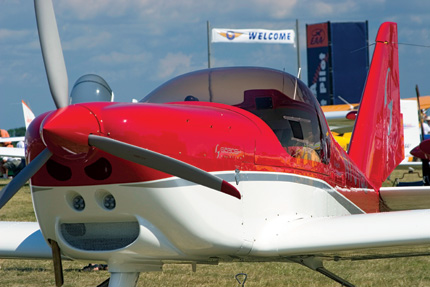 If there was ever any question regarding the viability of the LSA market, Cirrus and Cessna pretty much erased those concerns with announcements of their own LSAs at AirVenture 2007. Both companies obviously hope to lure new pilots to their step-up models.
If there was ever any question regarding the viability of the LSA market, Cirrus and Cessna pretty much erased those concerns with announcements of their own LSAs at AirVenture 2007. Both companies obviously hope to lure new pilots to their step-up models.
While such endorsements by the world's two most successful GA manufacturers certainly lent an air of legitimacy, they also may have made it tougher for smaller companies entering the field.
But it's these smaller companies, like Gobosh Aviation of Moline, Ill., that have paved the way and grown the LSA market such that larger companies are taking notice. The Gobosh G700S was also introduced at Oshkosh, and it will be competing head-to-head with Cessna, Cirrus and about 60 other companies.
The G700S is the product of Tomasz Antoniewski, a Polish designer with nearly 20 years in the aircraft business in his native country. In conjunction with the Polish company, Aero Sp. z.o.o., Antoniewski has conceived what looks more like a Lancair 235 than an LSA.
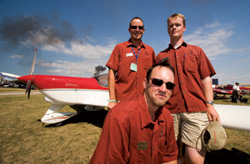 Here in the States, Gobosh is launching an aggressive campaign to bring its G700S to aviation's masses. Tony Settember runs a Gobosh dealership, Foothill Aircraft (www.foothillaircraft.com), at Cable Airport in Upland, Calif., and volunteered his demonstrator for our test flight.
Here in the States, Gobosh is launching an aggressive campaign to bring its G700S to aviation's masses. Tony Settember runs a Gobosh dealership, Foothill Aircraft (www.foothillaircraft.com), at Cable Airport in Upland, Calif., and volunteered his demonstrator for our test flight.
The Gobosh subscribes to many of the usual features of most LSAs. It mounts the Rotax 912 ULS, standard engine for the class, cranking out a maximum 100 hp. Prop is a three-blade, 68-inch, fixed-pitch, composite tractor. The G700S sports a 41-inch-wide cabin, 18.5-gallon fuel capacity and a fully equipped 500-pound payload. Gross is the max allowable 1,320 pounds, and the sprung-steel landing gear is fixed, per U.S. regulations.
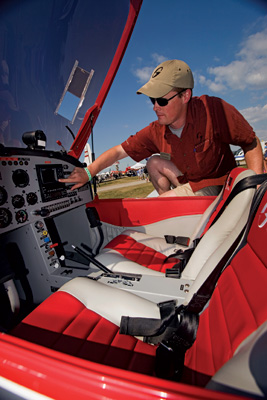 |
| The two-seater has a 41-inch-wide cabin with color-matched leather seats and custom-molded control sticks. Two small baggage compartments are directly behind the seats. |
After that, the Gobosh departs from the norm in many areas. Gobosh likes to call its airplane a "luxury-sport aircraft" in view of its differences from the standard LSA.
The G700S is composed of an all-metal construction rather than the more typical composite materials. Composites are renowned as the material of choice for construction of LSAs and homebuilts, primarily because working with fiberglass and other composite materials is simpler and less expensive. Building a glass airplane doesn't require large, heavy tools or excessive construction space.
This is a factory-built machine, however, not a homebuilt, and Gobosh feels metal construction is superior, equally as strong and light as composites. Similarly, metal surfaces mean you can paint the airplane any color you wish without worrying about composite temperature tolerances.
Wing skins are single-sheet aluminum from root to tip for a smooth top surface, and those areas that do require riveting receive standard rivets rather than the more obtrusive blind rivets. Gobosh components are anodized, a corrosion-proofing process superior to the more typical zinc chromating. Steel parts are cadmium-plated, and the airplane features a large number of hinged inspection doors for access to all systems. The fit and finish is easily the equal of normal-category certified airplanes. (In fact, the Gobosh G700S is fully certified in Europe.)
Interior appointments are also a cut above, embracing color-matched leather seats, custom-molded control sticks and other features that are optional or unavailable on some LSAs. There are two small baggage compartments directly behind the seats that can store a small suitcase and miscellaneous stuff.
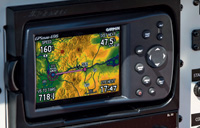 |
| The Gobosh is offered in three varieties. The top-of-the-line Elite Plus features the Garmin 496 GPSMAP (below, right) and GTX 327 transponder, PS Engineering PM-3000 Stereo Intercom and Beyerdynamic HS 300 headsets. |
The Gobosh sits low on the ramp, with a swept tail, spiffily spatted wheel pants, a signature mackerel-mouth air scoop beneath the cowling and a semi-bubble canopy for maximum visibility in every direction except straight down. Regardless of how it does in the sales race, there's little question the G700S is an aesthetic winner.
Pilot and passenger climb over the sidewall and reside abeam the main wing spar, the most stable position and prime location directly above the normal CG. The canopy hinges at the front and folds down to enclose pilot and passenger in a roof of Plexiglas.
Performance is about what we've come to expect from LSAs. Climb runs between 750 and 850 fpm from sea-level, standard airports. Level at 7,500 feet, the Gobosh offers about 116 knots max cruise. Fuel burn at 75% with the 100 hp Rotax out front is just under 4 gph, so you can reasonably plan to range out 3.5 hours before you'll need to stop for fuel. That should allow a radius of operation of 400 nm at max cruise. Service ceiling is 13,200 feet.
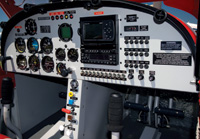 |
| The Gobosh climbs between 750 and 850 fpm and reaches a 116-knot cruise speed at 7,500 feet. Fuel burn at 75% is nearly 4 gph, allowing for a 3.5-hour range. |
Almost by definition, LSAs are committed to better short-field performance than normal-category airplanes. The type has been employed on private grass and turf strips in Europe for two decades. Gentlemen farmers and owners of wineries and country homes in the UK and on the Continent often clear away the brush and use personal aircraft as private transport from their back door to major terminals.
Handling is light and fun, with pitch by far the most sensitive control axis. Roll rate is good, but not nearly as quick as the elevator. This is a rudder airplane, so you'll need to keep your feet moving during maneuvers to avoid embarrassing yourself as I did.
With a 39-knot dirty stall speed, the Gobosh sports predictably excellent short-field performance. Stalls are no-brainers with no tendency to roll off on a wing, so you can make approaches as slow as 55 knots without tempting fate. If you accidentally decel into a stall during approach, the plane recovers with a slight reduction of back pressure and a little power.
Perhaps surprisingly, the airplane can jump off in just over half the runway required for landing. That's exactly the opposite of most aircraft, STOL or not, that can land in a short distance but require more runway for takeoff.
Like many of the LSA manufacturers, Gobosh is hoping to position its airplane as a contender for the training dollar. The airplane flies so well, maneuvers so easily and is so simple to operate that it may be a sure winner on the training market, providing Gobosh succeeds in differentiating its model from what's becoming a crowded class.
There are many LSAs vying for attention on the marketplace, some built here in the States, and many more imported from overseas. LSAs have only been approved for 2½ years, so that represents major competition. There's little question that many of those 60 models will fall by the wayside in the near future.
The Gobosh comes in three flavors. At $106,950, the entry-level Sport is a basic day/VFR version with a Garmin 296 GPSMAP, 327 transponder and PS Engineering PM-3000 Stereo Intercom. The middle model is the Elite---day/night /VFR legal and fitted with a Garmin 396 GPSMAP, 327 transponder and SL40 com plus the PM intercom---at $116,850. Finally, the top-of-the-line Elite Plus G700S ($123,900) sports the Garmin 496/327/PM-3000, an upgraded SL30 navcom and a pair of Beyerdynamic HS 300 headsets.
That puts the G700S head-to-head with the new Cessna 162 SkyCatcher, still a year down the road from release but already tough psychological competition. For those pilots who embrace low-wing over high-wing, the Gobosh will still command its share of attention, and since nearly all LSAs are right up against the FAA's performance and weight limits, climb and speed won't vary much from one model to the next.
Low-wing or high-wing---which would you choose?
SPECS: 2007 Gobosh G700S

Subscribe to Our Newsletter
Get the latest Plane & Pilot Magazine stories delivered directly to your inbox





